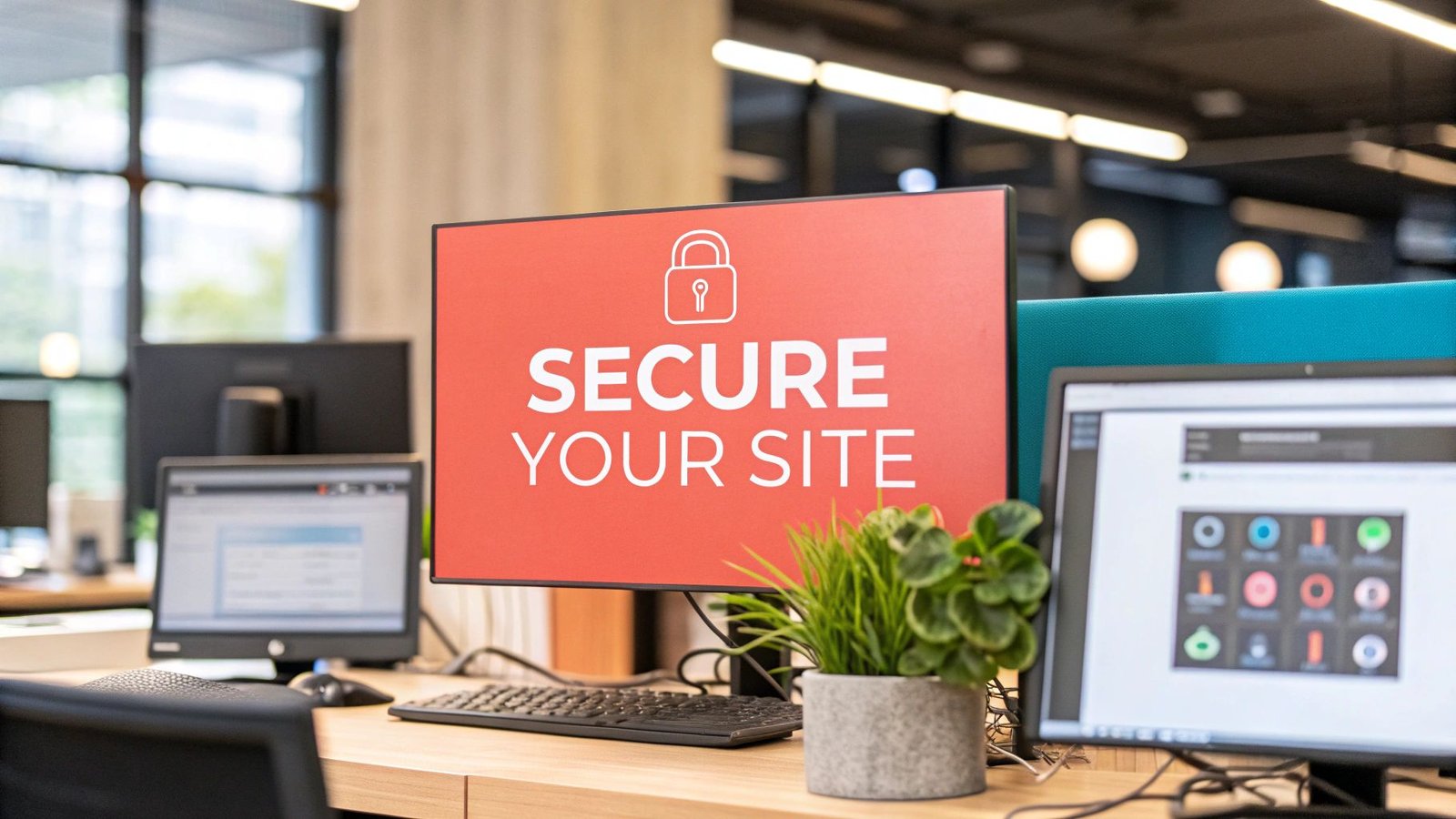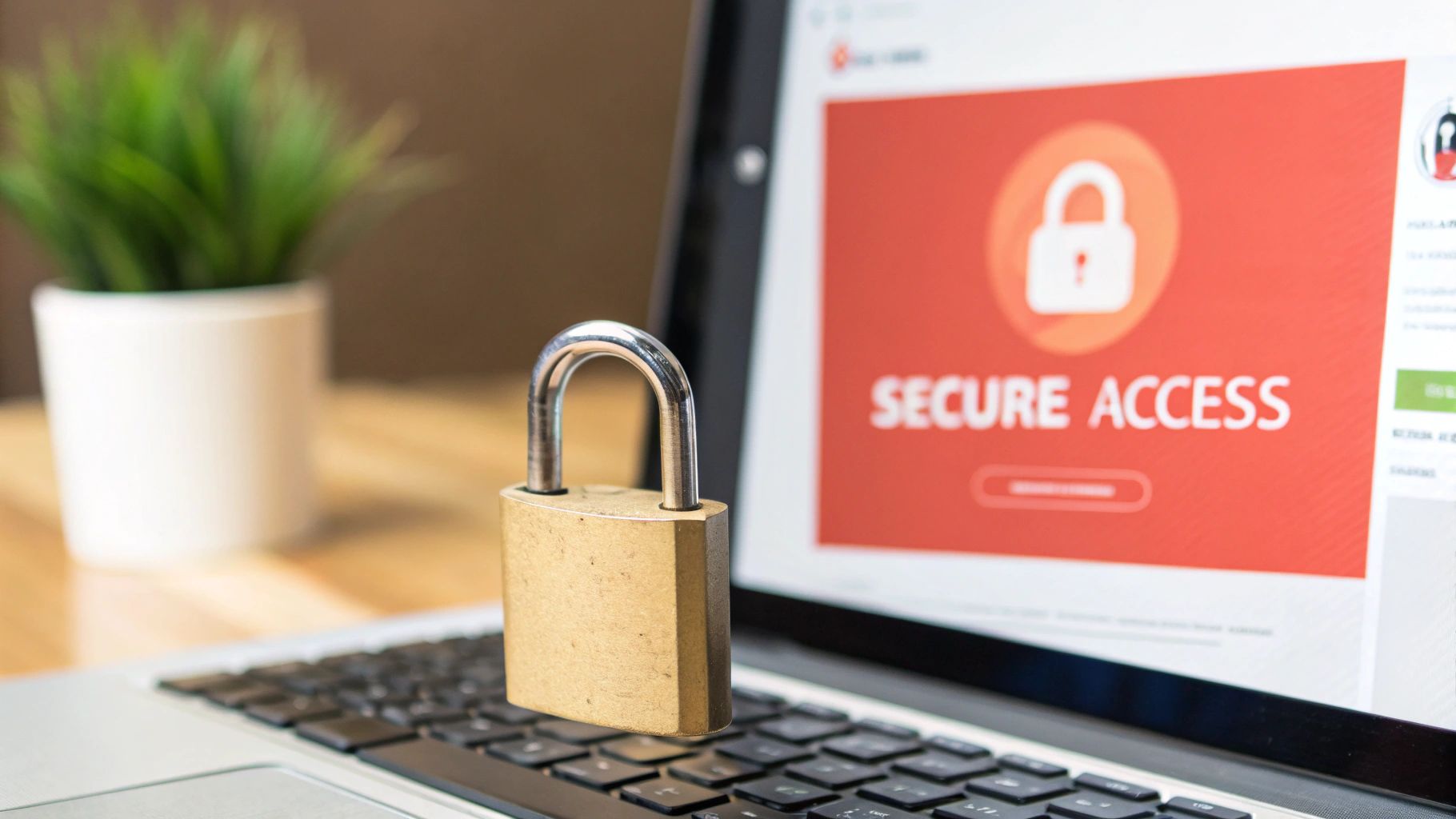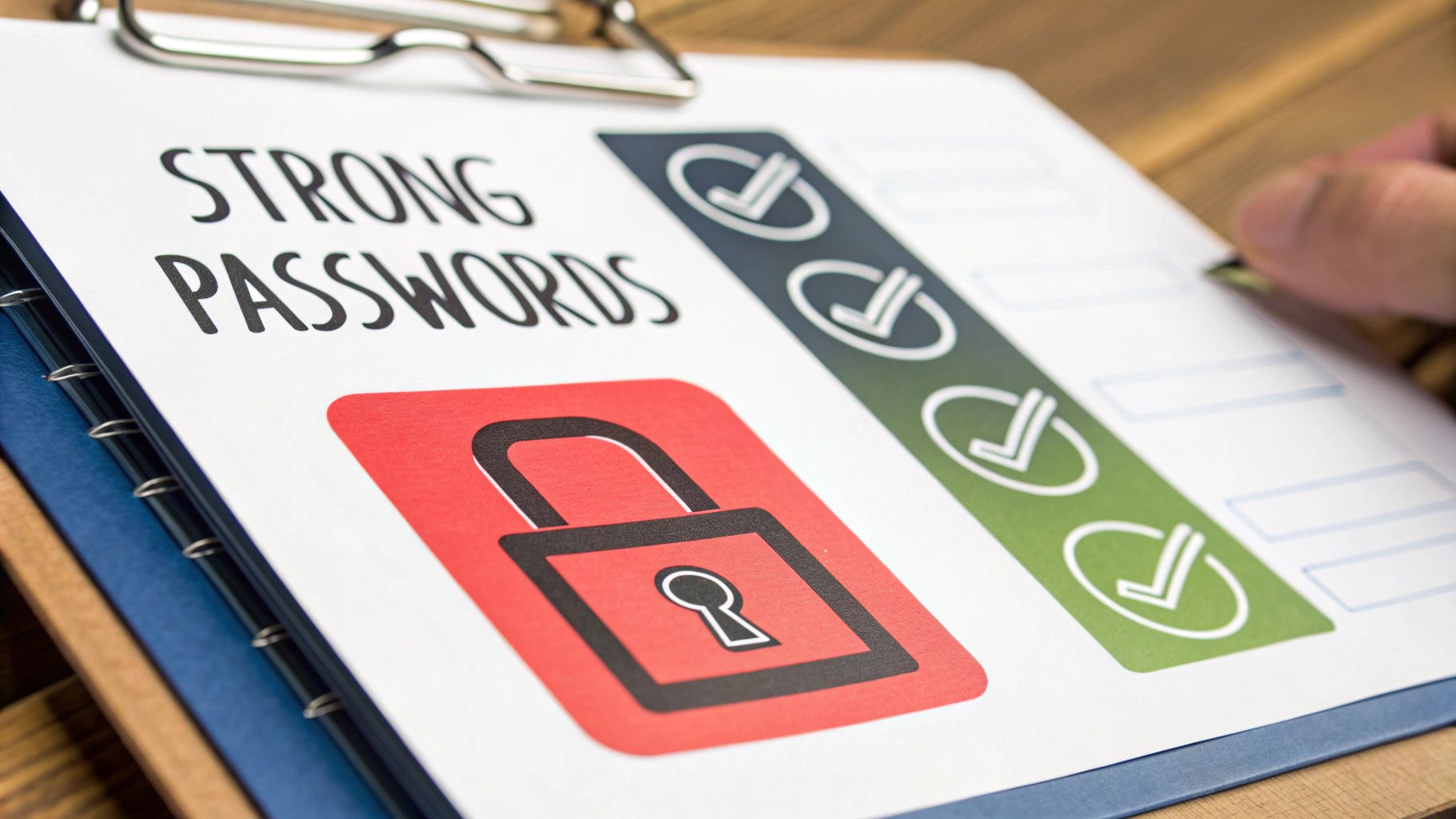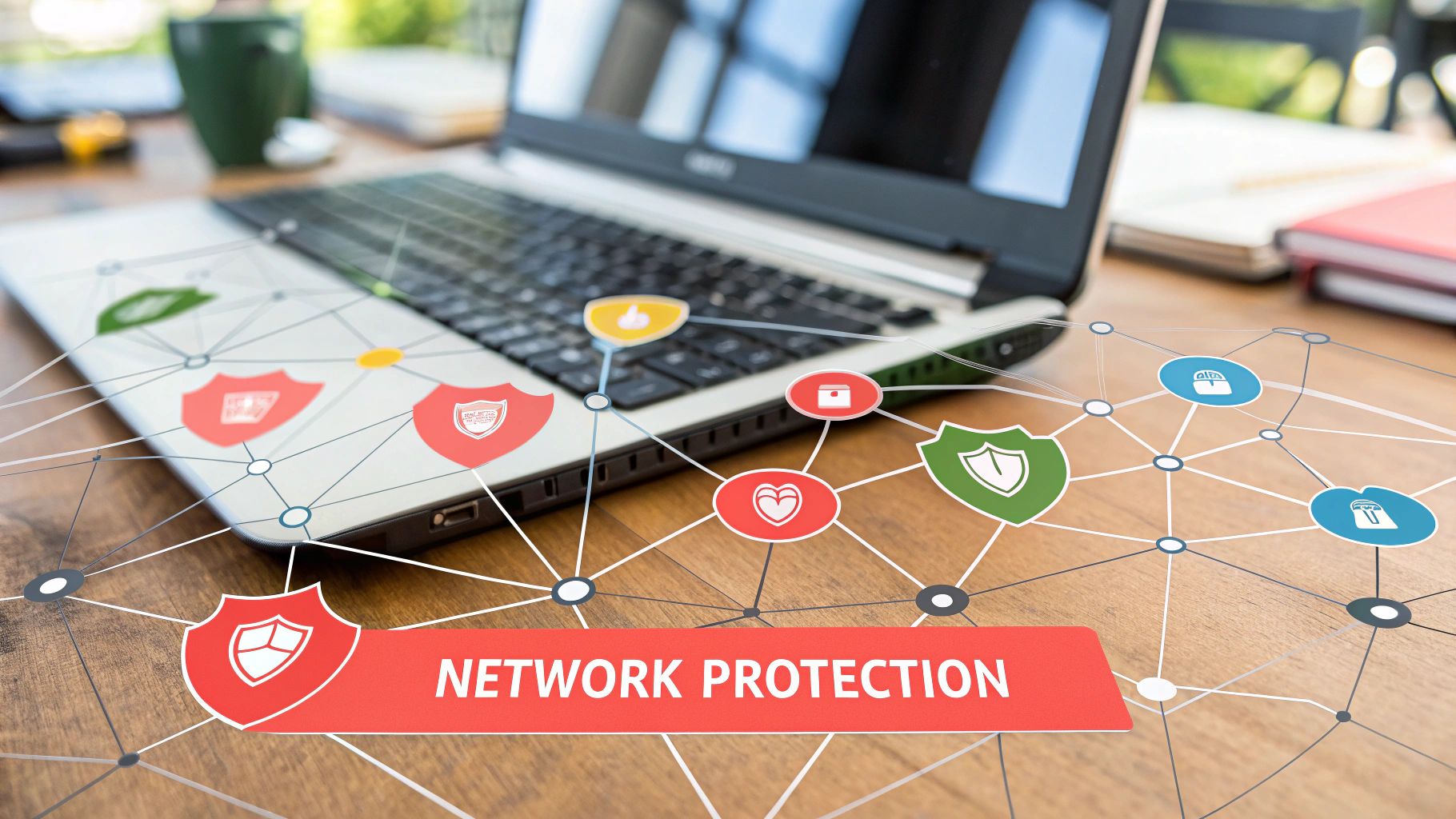
Understanding Today's Digital Security Landscape

Online security threats have become a critical concern for businesses of all sizes. As companies expand their digital presence, protecting sensitive data and systems has shifted from optional to essential. The stakes are high – a single security breach can devastate a company through financial losses, legal issues, and permanent reputation damage.
The Evolving Threat Landscape
Security threats are becoming more complex and frequent with each passing day. As organizations strengthen their defenses, attackers develop new techniques to bypass them. One week might bring password attacks, while the next sees sophisticated phishing schemes or new software vulnerabilities being exploited. This constant back-and-forth makes security an ongoing challenge rather than a one-time fix.
The sheer scale of attacks is concerning. Research shows approximately 30,000 websites are compromised daily, with a new attack occurring every 39 seconds on average. No organization is immune – small and medium businesses are particularly targeted since attackers often view them as having weaker security. This makes robust protection vital for companies of all sizes.
Beyond the Financial Impact
While security breaches bring obvious financial costs through fines and legal fees, their impact extends much further. Customer trust, built over years, can vanish overnight. Business operations grind to a halt. Staff morale suffers. The ripple effects often include lost customers, difficulty attracting new business, and key employee departures. This broader impact shows why proactive security is an investment in business sustainability, not just cost avoidance.
Assessing Your Security Posture
Before implementing security measures, organizations must understand their current vulnerabilities and risks. This means reviewing existing protections, identifying weak points, and creating a security strategy aligned with business needs.
| Aspect | Questions to Ask |
|---|---|
| Software | Are all software components, including plugins and themes, regularly updated? |
| Authentication | Are strong passwords enforced, and is two-factor authentication implemented? |
| SSL/HTTPS | Is HTTPS enabled and configured correctly? |
| Security Monitoring | Are systems in place to detect and respond to security incidents in real-time? |
| Incident Response Plan | Is there a documented plan for handling security breaches? |
This assessment lays the groundwork for building effective security practices. The following sections will explore specific measures organizations can take to protect their digital assets and support long-term business success.
Building Your Security Foundation with SSL
Setting up proper website security starts with a strong SSL/TLS certificate. This digital security measure encrypts data flowing between your website and visitors, much like a lock protecting valuable contents. However, simply having an SSL certificate isn't enough – proper configuration and maintenance are essential for real protection.
Validating Your SSL Setup and Configuration
Once you have your SSL certificate installed, thorough validation is key. This process identifies potential security gaps and misconfigurations that could leave your site exposed. Several online tools can help assess your SSL implementation and highlight areas needing improvement. For example, Qualys SSL Labs provides detailed testing that grades your configuration and points out vulnerabilities that need addressing.
Common SSL Misconfigurations and Their Impact
Many websites have security gaps due to basic SSL setup mistakes. Using old SSL/TLS protocols is one frequent error that exposes sites to known security flaws. Another common issue is incorrect certificate chain configuration, which triggers browser security warnings and damages visitor trust. These types of misconfigurations essentially cancel out the benefits of having SSL protection, making your site an easier target.
Maximizing Protection with HSTS and Certificate Transparency
To strengthen your SSL security further, consider implementing HTTP Strict Transport Security (HSTS) and Certificate Transparency. HSTS requires browsers to only connect via HTTPS, blocking attempts to intercept data over unsecured HTTP. Certificate Transparency makes your SSL certificates publicly verifiable, helping prevent fraudulent certificates from being issued for your domain. Together, these features add important layers of protection beyond basic SSL.
Managing Certificates Across Complex Infrastructures
For sites with multiple domains or complex setups, proper certificate management becomes critical. Manual tracking of numerous certificates is time-consuming and risky, as expired or misconfigured certificates can take sites offline. Automated tools like Let's Encrypt offer free SSL certificates with automated renewal, making certificate management simpler even for smaller websites. This systematic approach to SSL helps maintain consistent security and minimize disruptions. By carefully configuring, monitoring and managing your SSL certificates, you create strong protection for both your website and its visitors.
Mastering CMS Security and Updates

Every website owner who uses popular content management systems like WordPress, Drupal, and Joomla enjoys their powerful features and flexibility. But this same flexibility can create security risks, especially when using third-party plugins and themes. That's why proper security management and timely updates are essential for protecting your website.
Evaluating Third-Party Components
Before adding any new plugin or theme to your site, take time to carefully review it. Check user reviews and ratings to understand others' experiences. Pay special attention to the developer's track record in addressing security issues and responding to bug reports. A plugin with a history of vulnerabilities or an unresponsive developer should raise red flags. Make sure the component works with your current CMS version and receives regular maintenance updates. This basic due diligence helps prevent known security issues from affecting your site.
Automating Updates Without Breaking Your Site
Regular updates form the foundation of good website security by patching vulnerabilities and protecting against new threats. However, updates sometimes cause compatibility problems. That's where automated update tools come in handy. Most hosting providers offer staging environments where you can safely test updates before applying them to your live site. You can also use specialized plugins designed for managing updates. This way, you can catch and fix any issues before they impact your visitors.
Minimizing Vulnerability Windows
The time between discovering a security flaw and applying a fix creates a window of vulnerability. To keep this window as small as possible, stay informed about security announcements for your CMS and plugins. Subscribe to security mailing lists and enable automatic updates for minor releases and patches. Quick action when issues arise helps protect your site from exploitation. Taking these proactive steps significantly reduces your exposure to security threats.
Building a Security-Focused Update Strategy
A clear update schedule helps balance security needs with website stability. Rather than updating randomly, create a structured approach. Schedule non-critical updates during quiet periods and apply security patches immediately when released. Here's a recommended update framework:
| Component Type | Update Frequency | Testing Required? |
|---|---|---|
| Core CMS | As soon as possible | Yes, in a staging environment |
| Security Plugins | Immediately | Ideally, yes |
| Other Plugins | Regularly (e.g., monthly) | Recommended |
| Themes | Regularly (e.g., quarterly) | Yes, in a staging environment |
Following this organized approach to CMS security and updates helps create strong defenses for your website. When combined with other security best practices, it provides reliable protection that keeps your online presence secure.
Creating Bulletproof Authentication Systems
A strong authentication system is the first line of defense in protecting your website and user data. Simple username and password combinations are no longer enough to guard against today's security threats. Building effective authentication requires carefully balancing robust security measures with a smooth user experience.
Two-Factor Authentication: Doubling Down on Security
Much like a bank vault requiring both a key and combination to open, two-factor authentication (2FA) adds an essential second layer of protection by requiring two separate forms of identification. Even if attackers obtain a password, they still can't access accounts without the second factor.
- Time-Based One-Time Passwords (TOTP): Apps like Google Authenticator generate temporary codes that expire every 30 seconds. This approach is both user-friendly and highly secure since the codes can't be reused.
- Hardware Tokens: Physical security keys provide excellent protection against phishing, though they're less convenient than authenticator apps. Popular options include YubiKey devices.
For instance, when accessing online banking, 2FA ensures that even if criminals steal your password through a phishing email, they still can't log in without access to your phone or security key to generate the second verification code.
Effective Session Management: Keeping the Door Locked
Good session management determines how long users stay logged in and prevents unauthorized access, similar to a door that automatically locks after a set time. Key aspects include:
- Smart timeout settings: Configure automatic logouts after periods of inactivity based on security needs and user patterns
- Secure session IDs: Generate random, unpredictable identifiers to prevent session hijacking attempts
- Session ID rotation: Create new session IDs after each login to stop attackers from forcing users onto compromised sessions
Secure Password Recovery: Helping Users Without Compromising Security
Password recovery is often a weak point in authentication systems. Here's how to make it both secure and user-friendly:
- Multi-channel verification: Request proof of identity through multiple methods like email and SMS before allowing password resets
- Rate limiting: Cap the number of reset attempts to block brute force attacks
- Secure reset links: Never email passwords directly – send time-limited reset links that expire quickly
Defending Against Credential Stuffing
Credential stuffing attacks use stolen username/password combinations from other sites to break into accounts. Protect your site with these measures:
- Login monitoring: Track failed attempts by IP address to detect automated attacks early
- Bot prevention: Add CAPTCHA checks and similar tools to stop automated login attempts
- Risk-based authentication: Trigger extra verification steps for suspicious login patterns, like attempts from unusual locations
Following these authentication best practices creates a strong security foundation while maintaining good user experience. Regular testing and updates help keep your authentication system resilient against emerging threats.
Implementing Real-Time Security Monitoring

While robust authentication and a secure CMS form the foundation of website security, continuous monitoring is essential for staying ahead of emerging threats. Real-time security monitoring acts like a vigilant guard, watching your website 24/7 to catch suspicious activity early. Rather than just reviewing logs after the fact, it actively identifies and stops potential attacks before they cause damage. This proactive approach has become a core component of effective website protection.
Recognizing Attack Patterns Through Monitoring
To detect threats effectively, you need to understand common attack patterns and warning signs. For example, if you notice a sudden flood of traffic from one IP address, it could signal a denial-of-service (DDoS) attack attempting to overload your server. Multiple failed login attempts, especially with non-existent usernames, often indicate someone trying to guess passwords through brute force. That's why carefully analyzing traffic patterns, login activity, and user behavior in real-time is crucial. When a user starts accessing unusual files or performing atypical actions, it may mean their account has been compromised.
Choosing the Right Security Tools
Success in security monitoring depends heavily on selecting appropriate tools for your needs. Intrusion detection and prevention systems watch network traffic and automatically block known malicious sources. Web application firewalls specifically target attacks like SQL injection and cross-site scripting that target websites. Security information and event management (SIEM) platforms gather data from various security tools to provide a complete view of your security status, making it easier to spot concerning patterns. Regular vulnerability scans help find weaknesses before attackers do. While many commercial and open-source options exist, choose tools that align with your specific requirements and resources.
Developing a Robust Incident Response Plan
Even excellent monitoring can't prevent every breach, so you need a clear incident response plan. This should outline specific steps to take after detecting a security incident – from isolating affected systems to identifying the breach's scope and restoring services. Your plan might include details like how to properly take a compromised server offline, notify impacted users, and recover data from backups. Regular testing helps ensure the plan stays current and effective. Clear communication channels are vital so everyone knows their role during an incident. Like fire drills prepare people for emergencies, practicing your response plan helps teams stay calm and act quickly when real incidents occur.
Establishing Monitoring Thresholds and Workflows
Since monitoring generates constant data, setting smart alert thresholds helps avoid alarm fatigue. Configure your system to only notify you about genuinely suspicious events. For instance, define thresholds for failed login attempts that can distinguish between normal user errors and actual attacks. Create clear procedures for handling alerts, rating incident priority, and escalating issues to the right teams. Connect your monitoring tools to communication platforms like Slack so alerts reach the right people quickly. When you fine-tune these thresholds and workflows, your security monitoring runs smoothly without unnecessary disruptions.
Developing Your Complete Security Strategy

While individual security practices like strong authentication and monitoring are essential, they work best as part of a broader strategy. By connecting different security elements into one cohesive system, you can better protect your website as threats continue to evolve.
Conducting Thorough Security Audits
Regular security audits serve as critical health checks for your website. Just like a medical checkup helps identify health issues early, security audits spot potential vulnerabilities before attackers can take advantage of them. A proper audit examines everything from server settings and access controls to code security and incident response plans. For example, audits often uncover issues like outdated software, weak passwords, or gaps in security monitoring. To ensure nothing is missed, it's best to combine internal reviews with assessments from external security experts.
Empowering Your Team With Security Training
Human error can undermine even the strongest security systems. That's why ongoing security training for all staff members is crucial. Your training program should teach practical skills like spotting phishing attempts, creating secure passwords, and following data protection protocols. For instance, when employees learn to recognize suspicious email links, malware infections drop significantly. Equally important is teaching staff to quickly report any security concerns they notice. Good training turns your team into active participants in protecting your website.
Disaster Recovery: Beyond Backups
While backups are vital, effective disaster recovery requires much more. A complete plan includes step-by-step procedures for restoring all website functions quickly after an incident. This means having a dedicated recovery team, documented restoration steps, and clear communication plans. When servers fail or websites get compromised, you need a proven roadmap to get back online fast. Recent studies show that extended downtime after cyber attacks often leads to business failures, highlighting why strong recovery plans matter.
Risk Assessment and Resource Allocation
Understanding your specific security risks helps focus your efforts where they matter most. Through careful risk assessment, you can identify your critical assets, likely attack methods, and potential impacts. This knowledge helps you spend your security budget wisely. An online store might prioritize protecting payment data, while a content site focuses on preventing defacement. By analyzing your unique risks, you can build security measures that address your actual vulnerabilities.
Measuring Security Effectiveness
Regular measurement shows if your security practices actually work. Track key data like security incident numbers, resolution times, and website availability. This information reveals where you need improvements and helps prove the value of security investments. For example, if you notice phishing attempts succeeding more often, you may need to enhance your staff training.
Are you ready to improve your website security? Vgotweb provides expert security solutions designed for your needs. From website development to security implementation, we offer complete services to protect your online presence. Visit https://vgotweb.com to learn more about securing your website today.

